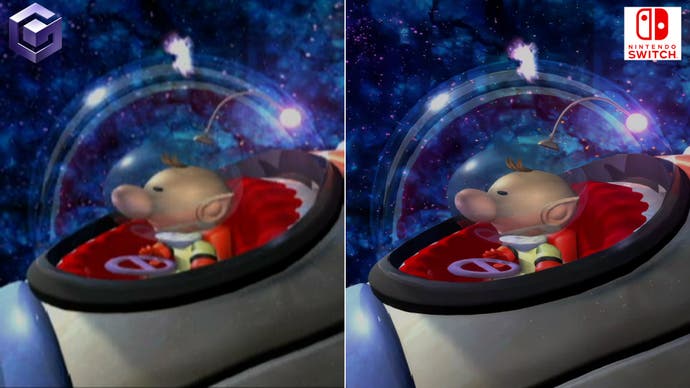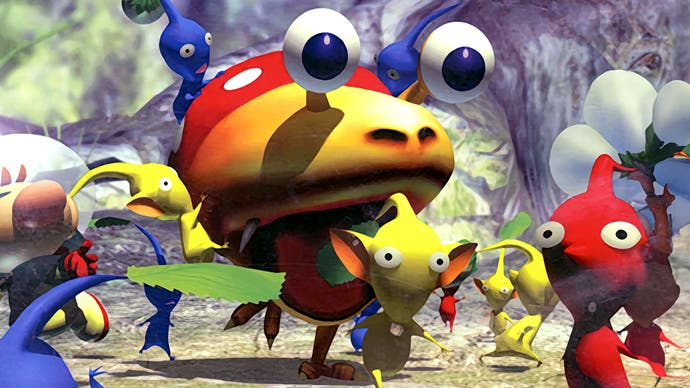Pikmin 1+2 on Switch gets the job done - but it could have been so much more
If modders can deliver HD textures and 60fps, why can't Nintendo?
There's never been a better time to get into the Pikmin series. Pikmin 4 of course has just hit shelves - but for those keen to explore the origins of the series, Nintendo has you covered with the release of Pikmin 1 and 2 on Switch. It's not described as a remaster and it's certainly not a remake, merely an 'HD version' and understanding this is key to measuring our expectations going in. This package of Pikmin games does more or less exactly what it says on the tin. You get both GameCube classics, presented at a higher resolution, with a few extra tweaks to sweeten the deal - such as upgraded cut-scenes. So how does Pikmin 1 and Pikmin 2 on Switch ultimately stack up to the 2001 and 2004 GameCube originals? And how does performance hold up - bearing in mind this appears to partly run through emulation on Switch?
The tech behind Pikmin's rendering of so many individual units on-screen was, of course, originally made famous with the Super Mario 128 demo - a tech showcase for the Nintendo Gamecube as seen at the Spaceworld 2000 event. Seeing 128 iterations of Mario running around was a great visual example of the Gamecube's processing power, but it wasn't a fully-formed game by any means. However, the use of object physics, the ability to calculate more actions on-screen and the higher polygon count possible on then next-gen hardware was remarkable to behold at the time. The idea of so many characters manipulated by the GameCube's analogue sticks didn't explicitly find its way into any actual Mario-branded game. The seed of this idea clearly translated well to a potential RTS-style project, and sure enough, Miyamoto has since confirmed that those wanting to play the Mario 128 demo - with all these units on-screen - had already essentially played it, in the form of Pikmin 2.
Perhaps the biggest challenge faced by the Pikmin series is just explaining what the game actually is. At its core, Pikmin is a real time strategy game, mixed with puzzle-solving elements. You take charge of Captain Olimar, whose plane crash lands on a mysterious planet. The mission? To collect all the missing parts of his ship by commanding up to a hundred tiny ant-like creatures. You direct a growing army towards resources: fruit, scrap salvage, or even larger insects to attack. Dragging each object back to the base produces even more Pikmin via seeds, which in turn, means you're able to attack, and collect even bigger things. The more Pikmin you have, the better. The peril is in finding these spaceship parts within a time limit of 30 days, with each day cycle passing by at the top of the screen. On top of that, Pikmin are vulnerable to the creatures roaming the world, and some - barring the blue Pikmin - also drown in water.
It's an addictive formula. And being a first-time player myself with this Switch release, I found a huge satisfaction in seeing a small smattering of Pikmin grow into an army. It's held up well: once you reach that 100 Pikmin mark, a big part of the challenge is in juggling your expeditions to find more parts for the spaceship, while also keeping your Pikmin numbers afloat. Even today it's an utterly unique, original creation - and sorely unappreciated at release I think. The sequel, Pikmin 2, landed on GameCube in 2004: a slicker, better presented effort with UI improvements, cutscenes, and more of a narrative push. The ability to switch between two Captains - Olimar and Louie - added to the depth, and I'm glad to say Pikmin 2 and the original are both very playable on Nintendo Switch, even if they are, to be blunt, quite barebones.
So how exactly have Pikmin 1 and 2 been translated to Switch? Curiously, based on findings from OatmealDome on Twitter, it appears to use a similar hybrid emulation system to Mario Sunshine's re-release on Switch, from the Mario 3D All-Stars package. It's the same technology at its core. Pikmin 1 and 2 run on an emulator called 'hagi' - Nintendo's own proprietary GameCube and Wii emulator, which emulates the GPU functions of the GameCube, while the CPU side is compiled to run natively on Switch. It's an approach that broadly speaking works in delivering accurate results, true to the GameCube originals, while also opening the game up to some embellishments.
The most obvious upgrade is the boost to a native 1920x1080 image on Switch. Both games get the full HD treatment while Switch is docked, presented in widescreen of course, which has a huge practical benefit to playability, especially so when using the farthest zoom mode. Pulling the camera right out for a top-down view, every Pikmin and each seed outside the Onion ship stay crystal clear at range. It's a point that the original GameCube - and even Wii re-releases - struggled to handle by rendering at a native 480p.

The Switch version gets off to a great start by boosting the resolution, but of course, running either game in portable mode means they render at 720p instead, which is still fine as a 1:1 pixel match for the display. The only downside is that there's no anti-aliasing applied whatsoever to the image in either docked or portable modes. Expect some rough edges and some pixel shimmer, though it's a decent, crisp looking image overall. It's also encouraging to see the font, the UI in menus and gameplay are also upgraded in concert with the res boost on Switch. These elements were beautifully designed on GameCube, but the original 2D assets just wouldn't have held up to scrutiny today, left as is. As it's such a crucial way to track the gameplay in terms of the number of Pikmin and the time left in a day, Nintendo's made the right call in bringing the UI up to standard.
With the 1080p resolution boost in mind, there's no skirting around the biggest downside with this package: the low texture quality. Many of the texture assets stay entirely untouched from the original GameCube release, right down to the low-resolution floor asset of the opening planet. Character models for Captain Olimar and the Pikmin are simplistic but they at least carry a certain charm even today. The textures have not changed, however. Most assets were really designed around the GameCube's RAM limits, to be shown at 480p on a CRT. And so, despite the bump to 1080p on Switch, it's a shame that ultimately this HD release presents them just as they were with no added frills, albeit with a few exceptions in rare moments. Olimar's spaceship, for example, sees some improvement on the Switch HD release with higher quality assets for rust on the outer shell. For the most part though, most textures stay in place from 20 years ago.
One twist is the treatment of Pikmin's pre-rendered cutscenes. Pikmin 2 in particular has a few early on - and the good news is that these video files get a suitable 1080p reworking on Switch, delivering a noticeable upgrade. All signs point to these pre-rendered scenes being AI upscaled by Nintendo - using the GameCube originals as a base - and the results are excellent. Macroblock artefacts are cleaned up and remarkably, every detail, right down to the stars in the night sky, are now presented with a pin-sharp resolve. Helpfully, the original asset used a 16:9 aspect ratio letterboxed in a 4:3 container, which now fits well on today's displays.

In terms of performance, the fact is that both Pikmin 1 and 2 on Switch run at a locked 30 frames per second in gameplay. The upside is it is a perfect lock. Even with 100 Pikmin doing your bidding it barely misses a frame at 30fps. However, it's a missed chance to push to 60fps, given the processing power on tap with Switch. The silver lining is it's an evenly frame-paced 30fps cap, unlike recent efforts from Nintendo with Super Mario Sunshine on Switch. Much like the low quality textures though, it's a shame Nintendo didn't stretch themselves to make some easy wins. And it didn't have to be this way: GameCube emulators like Dolphin run Pikmin 1 and 2 at 60fps for example, and with fan mods even upgrading the textures, shaders and UI.
Taking a broad view of Pikmin 1 and 2 on Switch, there's no escaping the fact both are basic ports. It's a straight translation of each GameCube classic running at 1080p, at 30fps, with AI upscaled cut-scenes, a cleaner UI, but minimal improvements anywhere else. The saving grace is that the gameplay - especially in Pikmin 2 - holds up well enough that they're still worth revisiting. The verdict here boils down to the value proposition Nintendo is making for both games. In principle, seeing more GameCube classics like this make a return on Switch is absolutely fine, even if it's the bare minimum in terms of presentation. F-Zero GX, Mario Kart Double Dash and Super Smash Bros. Melee would be amazing to have at our fingertips on Switch. It's just the matter of the asking price.
There's also a case to be made that, really, Pikmin 1 and 2 should have seen much bigger upgrades - running at 60fps at least, given the amount of extra effort it would have taken to get there. As it stands, you get the authentic 30fps experience with GameCube era textures. Thankfully the games are enjoyable despite the 20-year time gap and ultimately, It's great to have an easy way to catch up on two under-appreciated Nintendo classics. It's just the barebones nature of the releases that is bothersome, when we know Nintendo could have delivered so much more.


